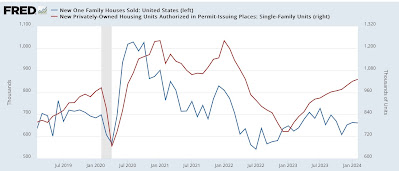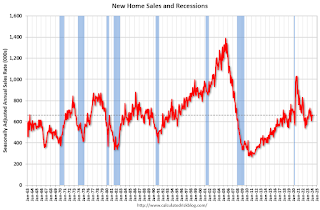Uncategorized
As mortgage rates remain rangebound, so do new home sales
– by New Deal democratLet’s begin this post by putting why I am watching new home sales in context.The economy was kept out of recession last year,…

- by New Deal democrat
Uncategorized
New Home Sales at 662,000 Annual Rate in February
The Census Bureau reports New Home Sales in February were at a seasonally adjusted annual rate (SAAR) of 662 thousand.
The previous three months were revised up slightly.
Sales of new single‐family houses in February 2024 were at a seasonally adjuste…

The previous three months were revised up slightly.
Sales of new single‐family houses in February 2024 were at a seasonally adjusted annual rate of 662,000, according to estimates released jointly today by the U.S. Census Bureau and the Department of Housing and Urban Development. This is 0.3 percent below the revised January rate of 664,000, but is 5.9 percent above the February 2023 estimate of 625,000.Click on graph for larger image.
emphasis added
The first graph shows New Home Sales vs. recessions since 1963. The dashed line is the current sales rate.
New home sales were close to pre-pandemic levels.
The second graph shows New Home Months of Supply.
 The months of supply increased in February to 8.4 months from 8.3 months in January.
The months of supply increased in February to 8.4 months from 8.3 months in January. The all-time record high was 12.2 months of supply in January 2009. The all-time record low was 3.3 months in August 2020.
This is well above the top of the normal range (about 4 to 6 months of supply is normal).
"The seasonally‐adjusted estimate of new houses for sale at the end of February was 463,000. This represents a supply of 8.4 months at the current sales rate."Sales were below expectations of 673 thousand SAAR, however, sales for the three previous months were revised up slightly. I'll have more later today. home sales pandemic
Uncategorized
Excessively high rents are a major burden for immigrants in US cities
The US economy relies on immigrants to fill jobs, but many of them are struggling with high rent burdens that make it harder to build productive lives…

Rents across the U.S. have climbed to staggering levels in recent years. Millions of renters spend more than 30% of their income on rent and utilities, a situation that housing experts call being cost burdened.
High rents affect almost all segments of the population but are an especially heavy burden for immigrants, particularly those who have not yet become U.S. citizens. Immigrants, both documented and undocumented, play important roles in the U.S. economy. They often provide the cheapest labor in the riskiest of industries. Yet they are still not broadly accepted or supported in many U.S. cities.
We are geographers who study housing market issues, including racial-ethnic diversity and housing affordability. Our research on Nashville, which has emerged as an immigrant metropolis in the Southern U.S., suggests that foreign-born residents who are not yet citizens are far more burdened by high rents than other groups.
Many immigrant workers in Nashville spend more than 50% of their incomes on rent. This makes it hard for them to afford education and job training, healthy food, health care and other necessities that can help them participate as productive residents. Heavy rent burdens undermine their ability to have a higher standard of living and to be included in mainstream society.
As immigrants increasingly fan out across the U.S., we believe cities receiving new foreign-born residents should anticipate a growing need for affordable housing.
Hard times for renters
The past 15 years have been challenging for renters across the U.S.. In the 2008-09 recession, which was triggered by a collapse in the housing market, millions lost their homes to foreclosure and became renters. Tighter financing made it harder for others to buy homes. By 2015, almost 43 million households had been pushed into renting.
Today about 37% of U.S. homes are occupied by renters. By 2020, almost 46% of U.S. renters paid more than 30% of their household income toward rent. As of June 2021, the median monthly rent in the 50 largest U.S. cities was $1,575 – an 8.1% increase from June 2020.
The heaviest rent burdens fall disproportionately on minorities. Almost 46% of African American-led renter households are rent burdened, compared with 34% of white households.
The COVID-19 pandemic worsened housing insecurity for people of color because of longstanding racially targeted policies and widespread health and economic disparities. Renters of color faced higher cost burdens and eviction rates. In Nashville, this was especially true in Latino and Somali communities.
Why immigrant housing matters
Immigration is the main driver of population growth in the U.S., which is important for filling jobs and boosting tax revenues. After dipping because of pandemic-era restrictions in 2020-22, immigration to the U.S. started growing again, adding 1.1 million new residents in 2023.
Foreign-born residents make up 7.15% of the U.S. population today. Most of these immigrants are not citizens, although more than 878,000 people became citizens in 2023. The median length of time these new citizens spent in the U.S. before becoming naturalized was seven years.
Nashville is the largest metropolis in Tennessee and one of the fastest-growing immigrant gateways in the South. It is home to over 37% of Tennessee’s Latino population and has been a major destination for Latinos and other foreign-born residents since the early 2000s.
For our research, we used census data estimates for 2015-19 from the National Historical Geographic Information System covering metro Nashville’s 13 counties, which contain 372 census tracts. We found that Nashville’s most racially and ethnically diverse neighborhoods had the highest levels of rent burden.
This includes census tracts with high shares of foreign-born residents who are not yet citizens, especially if those residents are Black or Latino. Our analysis of the 37 census tracts (10% of the region’s total) with the largest shares of foreign-born residents who are not yet citizens shows that the average monthly rent paid by a household in these tracts was $1,306.20, compared with $1,288.70 metrowide.
In the 37 tracts with the largest shares of Latino residents and Black residents, we found that about 21% of households spent more than 50% of their household income on rent.
Our findings corroborate other scholarly analyses of Nashville’s Somali refugees, who tend to be clustered in communities that also house other diverse groups, including Egyptians and other African immigrants. In these areas, gentrification and urban renewal have forced several Black and Somali communities from ownership into renting.
We believe specific groups of foreign-born residents may either have been ineligible or didn’t know how to apply for government-funded housing and rental assistance programs and may have had to rent from predatory landlords as a result. Some Muslim immigrants also avoid applying for bank loans because of a concept in Islamic banking called ribā, which views charging interest on loans as unjust and exploitative.
More encouragingly, we found that tracts with newer housing stock, built since 2000, have relatively lower rent burdens even though those tracts are home to many Black and non-Asian minority residents. This suggests that newer development has an important role to play in mitigating rent, especially in suburban, relatively affordable locations. In the 37 census tracts with the most foreign-born residents who are not yet citizens, about 28% of the total housing stock was built in 2000 or later, compared with 23% across Nashville.

Easing rent burdens
One of the best ways to mitigate rent burdens is to build more housing and create affordable housing. However, communities sometimes oppose affordable housing projects and pro-development zoning because of fears of crime, traffic congestion or populations viewed as undesirable. Nashville is not immune to this syndrome.
The cost of housing has been a heated topic in the Nashville region since the mid-2010s. A 2023 Urban Institute report recommended creating more affordable housing in Nashville by promoting partnerships among academic, faith-based and health care institutions that own land that could be developed for housing. And the Metropolitan Council for the Nashville region plans to substantially revamp building codes to promote new housing construction.
However, critics argue that the council gives too much weight to anti-development arguments. And there is little discussion of specific ways to help groups that are ineligible for benefits and assistance that are available to U.S. citizens.

A priority for cities
Our research shows that creating more rental opportunities can help reduce rent burdens for all. We see great potential to take this research further through community-based investigations of local nuances that may add to rent burdens, especially factors and processes that can’t be adequately captured in quantitative data analysis. Many local actors have important roles to play, including elected officials and local nonprofits and community organizations that work to promote rights for immigrants and refugees.
Given the important role that immigrants play in filling jobs and contributing to local economies, we believe that helping them afford housing is a smart strategy, especially for growth-oriented cities.
The authors do not work for, consult, own shares in or receive funding from any company or organization that would benefit from this article, and have disclosed no relevant affiliations beyond their academic appointment.
recession foreclosure pandemic covid-19 housing marketUncategorized
IRS Reveals Suspicious Signs It Looks For To Flag Incorrect Or Fraudulent Tax Credit Claims
IRS Reveals Suspicious Signs It Looks For To Flag Incorrect Or Fraudulent Tax Credit Claims
Authored by Tom Ozimek via The Epoch Times,
The…

Authored by Tom Ozimek via The Epoch Times,
The Internal Revenue Service (IRS) has revealed a series of specific suspicious red flags that could trigger enforcement actions when it comes to mistaken or fraudulent applications for a pandemic-era tax credit.
The IRS indicated in a March 20 notice that there are seven suspicious signs of a bad claim for the employee retention credit (ERC), which is a refundable tax credit designed for businesses that continued paying employees during COVID-19 shutdowns.
The reason the agency is now revealing these telltale signs of incorrect or fraudulent ERC claims is because March 22 is the deadline to apply for a voluntary disclosure program that will let employers who filed bad claims avoid penalties and interest.
Earlier, the IRS found that a large number of improper ERC claims were pushed by predatory promoters on unwitting businesses, with an investigation by the IRS Criminal Investigation (IRS-CI) division uncovering more than $2.8 billion of potentially fraudulent ERC claims.
To fight the wave of dubious ERC claims, the IRS said it had sharply increased compliance action through audits and criminal investigations, with more planned in the future.
However, because of the sheer number of wrongly filed ERC claims and the predatory promotions surrounding them, the IRS developed several ways to get taxpayers who incorrectly claimed the credit to pay it back with minimal penalty.
One of these is the voluntary disclosure program, which lets people who filed bad ERC claims come forward to the IRS and, in exchange for being forthcoming, they only have to pay back 80 percent of what they owe.
Another is a special claim withdrawal process, which lets businesses that filed a questionable claim to withdraw it and avoid the risk of getting an illegal refund that could prove costly.
Generally, anyone who improperly claims the ERC must pay it back, possibly with penalties and interest. The IRS has warned that a business or tax-exempt group could find itself in a much worse cash position if it has to pay back a bad claim than if it had never claimed it in the first place.
The IRS says its latest disclosure of seven warning signs of a bad ERC claim is meant to help businesses review if their claim is questionable and so give them the opportunity to take action by the March 22 deadline.
7 Bad Claim Red Flags
The first warning sign of a potentially bad ERC claim is that it’s claimed for all quarters for which it was available.
Some promoters who pushed employers to file ERC claims advised them to claim the credit for all available quarters, which may not align with eligibility criteria.
“Qualifying for all quarters is uncommon,” the IRS said in the notice, while urging businesses to carefully review their eligibility for each quarter if they want to make sure they don’t fall afoul of the law.
The second red flag that could alert the IRS to a potentially fraudulent or incorrect claim is that it was filed when there was no government order in place that fully or partially suspended the operations of the business claiming the credit.
Some promoters told businesses that they could claim the ERC when any government order was in place in their area, even one that didn’t require the employer to partially or fully suspend its operations.
“This is false,” the IRS said in the notice.
Eligibility for the ERC was limited to periods during which a COVID-19-related order (not guidance or recommendation) was in effect that fully or partially suspended a given employer’s operations.
The third suspicious sign was claiming the ERC for all wages paid to every employee on the payroll.
There were dollar limits and varying ERC amounts, with employers being required to meet certain regulations for wages to be considered qualified wages for a proper claim.
Employers who used the same credit amount across multiple tax periods for each employee is a standout red flag, the IRS says.
The fourth warning sign is claiming a credit solely based on supply chain disruption.
“A supply chain disruption by itself doesn’t qualify an employer for ERC,” the IRS says.
The fifth red flag is employers claiming a credit for the entire calendar quarter when operations were suspended for only part of that quarter.
“It’s possible, but uncommon, for an employer to qualify for ERC for the entire calendar quarter,” the IRS says.
If a pandemic-related government order suspended business operations for part of a given quarter, then the ERC cannot be legitimately claimed for the whole quarter.
The sixth warning sign is that a business that claimed the ERC didn’t employ anyone for part or all of the period for which they’re claiming it.
“Some taxpayers claimed the ERC but records available to the IRS show they didn’t have any employees,” the IRS said. “Others have claimed ERC for tax periods before they even had an employer identification number with the IRS, meaning the business didn’t exist during the eligibility period.”
The seventh red flag for businesses that should alert them that their ERC claim could be bad is if promoters told them that they had “nothing to lose” by filing one.
“Businesses that incorrectly claim the ERC risk repayment, penalties, interest, audit and other expenses,” the IRS says.
The ERC, which is somewhat complex, is available to employers, not individual taxpayers.
Since the program was enacted, over 3.6 million claims have come in, with the IRS saying that ERC-related fraud became worse over time.
Voluntary Disclosure Program
The IRS’s voluntary disclosure program, first unveiled in December 2023, lets employers who wrongly filed for the ERC get right with the tax authorities by admitting to the mistake.
In exchange for volunteering this information, businesses get to keep 20 percent of the incorrectly received credits, and they won’t be charged any interest or penalties on the remaining 80 percent that they repay.
Those that are unable to repay the 80 percent can potentially be approved for an installment agreement, which will let them pay it back over a longer period.
Program applicants must not be under criminal investigation, nor be under an IRS employment tax examination, nor can they have received an IRS notice and demand for repayment of the ERC.
The IRS is also using the program to get at unscrupulous promoters who used aggressive marketing techniques to lure businesses into wrongly claiming the ERC.
In order to qualify for the program, employers must provide the IRS with the names, addresses, and telephone numbers of any advisers or tax preparers who advised or assisted with the claims.
The deadline to apply for the voluntary disclosure program is March 22, 2024.
Interest on money owed to the IRS compounds daily and the failure-to-pay penalty accrues monthly and can rise to as much as 25 percent of the owed amount.
Withdrawal Program
Another program the IRS rolled out in October 2023 was a special withdrawal process that lets businesses that filed a questionable claim withdraw it and avoid the risk of costly penalties and interest.
The withdrawal option lets employers avoid future problems by withdrawing pending ERC claims if they suspect they may have been tricked into filing and have not yet been paid.
Even if a business has received the ERC refund check but hasn’t yet cashed or deposited it, it can still withdraw its claim.
Claims that are withdrawn will be treated by the IRS as if they were never filed, and the agency won’t impose penalties or interest.
-

 Spread & Containment2 weeks ago
Spread & Containment2 weeks agoIFM’s Hat Trick and Reflections On Option-To-Buy M&A
-

 Uncategorized1 month ago
Uncategorized1 month agoAll Of The Elements Are In Place For An Economic Crisis Of Staggering Proportions
-

 International2 weeks ago
International2 weeks agoEyePoint poaches medical chief from Apellis; Sandoz CFO, longtime BioNTech exec to retire
-

 Uncategorized1 month ago
Uncategorized1 month agoApparel Retailer Express Moving Toward Bankruptcy
-

 International3 days ago
International3 days agoParexel CEO to retire; CAR-T maker AffyImmune promotes business leader to chief executive
-

 International2 weeks ago
International2 weeks agoWalmart launches clever answer to Target’s new membership program
-

 Uncategorized1 month ago
Uncategorized1 month agoGOP Efforts To Shore Up Election Security In Swing States Face Challenges
-

 Uncategorized4 weeks ago
Uncategorized4 weeks agoKey Events This Week: All Eyes On Core PCE Amid Deluge Of Fed Speakers















